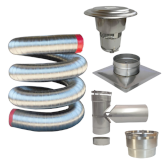I have an old 1980s fisher fireplace insert
currently I have a clay liner. I’ve attached some pics of the insert and flu. I think the flu is around 8” and the hole inside the insert is around 7”
Maybe 20 ft from top of insert to top of chimney.
I want to put a new stove pipe inside the flu so it's safe and attach it to the insert. I'm thinking about putting a 6" pipe in and adapting it to the top of the fisher insert. so if in the future I want to swap the insert out for a new more efficient insert, I don't need to replace the chimney pipe. I'm not too worried about it not drafting well, I'm more concerned about it being safe.
Does that sound like a good plan?
also can anyone suggest what pipe to use and how to adapt it to the top of the fisher insert? I've heard suggestions of using a cast iron boot.
I think I have a smoke shelf too, so I'll probably need to go at an angle to get around the smoke shelf to the straight chimney pipe.
Is anyone familiar with this process, have any pics/videos, suggest what pipe, boot/collar, and adapter to get from the top of the stove to the pipe?
all advice is very much appreciated.
![[Hearth.com] 1980s Fisher Insert adapt to chimney pipe [Hearth.com] 1980s Fisher Insert adapt to chimney pipe](https://www.hearth.com/talk/data/attachments/315/315234-a49ba0718d3e67660910bdfda4c028e1.jpg?hash=dtIHYoltdx)
![[Hearth.com] 1980s Fisher Insert adapt to chimney pipe [Hearth.com] 1980s Fisher Insert adapt to chimney pipe](https://www.hearth.com/talk/data/attachments/315/315235-bac8504cb2aad7058830e8c7c5f33de9.jpg?hash=MDCsNDc9Il)
![[Hearth.com] 1980s Fisher Insert adapt to chimney pipe [Hearth.com] 1980s Fisher Insert adapt to chimney pipe](https://www.hearth.com/talk/data/attachments/315/315236-7b6a10dd3e11c4ce9a5d64d7bb2765d9.jpg?hash=cjUD6UPCZm)
![[Hearth.com] 1980s Fisher Insert adapt to chimney pipe [Hearth.com] 1980s Fisher Insert adapt to chimney pipe](https://www.hearth.com/talk/data/attachments/315/315237-fe969540e2c68b7baeaa9348ce4cd700.jpg?hash=4Z4JOyziKz)
![[Hearth.com] 1980s Fisher Insert adapt to chimney pipe [Hearth.com] 1980s Fisher Insert adapt to chimney pipe](https://www.hearth.com/talk/data/attachments/315/315238-65e07a16c85a615510c7a61347ff9a86.jpg?hash=bXdPA8Bct9)
![[Hearth.com] 1980s Fisher Insert adapt to chimney pipe [Hearth.com] 1980s Fisher Insert adapt to chimney pipe](https://www.hearth.com/talk/data/attachments/315/315239-abea1fb7b2320a15a93c1f522f19c81b.jpg?hash=MeaUsKOlwO)
currently I have a clay liner. I’ve attached some pics of the insert and flu. I think the flu is around 8” and the hole inside the insert is around 7”
Maybe 20 ft from top of insert to top of chimney.
I want to put a new stove pipe inside the flu so it's safe and attach it to the insert. I'm thinking about putting a 6" pipe in and adapting it to the top of the fisher insert. so if in the future I want to swap the insert out for a new more efficient insert, I don't need to replace the chimney pipe. I'm not too worried about it not drafting well, I'm more concerned about it being safe.
Does that sound like a good plan?
also can anyone suggest what pipe to use and how to adapt it to the top of the fisher insert? I've heard suggestions of using a cast iron boot.
I think I have a smoke shelf too, so I'll probably need to go at an angle to get around the smoke shelf to the straight chimney pipe.
Is anyone familiar with this process, have any pics/videos, suggest what pipe, boot/collar, and adapter to get from the top of the stove to the pipe?
all advice is very much appreciated.
![[Hearth.com] 1980s Fisher Insert adapt to chimney pipe [Hearth.com] 1980s Fisher Insert adapt to chimney pipe](https://www.hearth.com/talk/data/attachments/315/315234-a49ba0718d3e67660910bdfda4c028e1.jpg?hash=dtIHYoltdx)
![[Hearth.com] 1980s Fisher Insert adapt to chimney pipe [Hearth.com] 1980s Fisher Insert adapt to chimney pipe](https://www.hearth.com/talk/data/attachments/315/315235-bac8504cb2aad7058830e8c7c5f33de9.jpg?hash=MDCsNDc9Il)
![[Hearth.com] 1980s Fisher Insert adapt to chimney pipe [Hearth.com] 1980s Fisher Insert adapt to chimney pipe](https://www.hearth.com/talk/data/attachments/315/315236-7b6a10dd3e11c4ce9a5d64d7bb2765d9.jpg?hash=cjUD6UPCZm)
![[Hearth.com] 1980s Fisher Insert adapt to chimney pipe [Hearth.com] 1980s Fisher Insert adapt to chimney pipe](https://www.hearth.com/talk/data/attachments/315/315237-fe969540e2c68b7baeaa9348ce4cd700.jpg?hash=4Z4JOyziKz)
![[Hearth.com] 1980s Fisher Insert adapt to chimney pipe [Hearth.com] 1980s Fisher Insert adapt to chimney pipe](https://www.hearth.com/talk/data/attachments/315/315238-65e07a16c85a615510c7a61347ff9a86.jpg?hash=bXdPA8Bct9)
![[Hearth.com] 1980s Fisher Insert adapt to chimney pipe [Hearth.com] 1980s Fisher Insert adapt to chimney pipe](https://www.hearth.com/talk/data/attachments/315/315239-abea1fb7b2320a15a93c1f522f19c81b.jpg?hash=MeaUsKOlwO)


